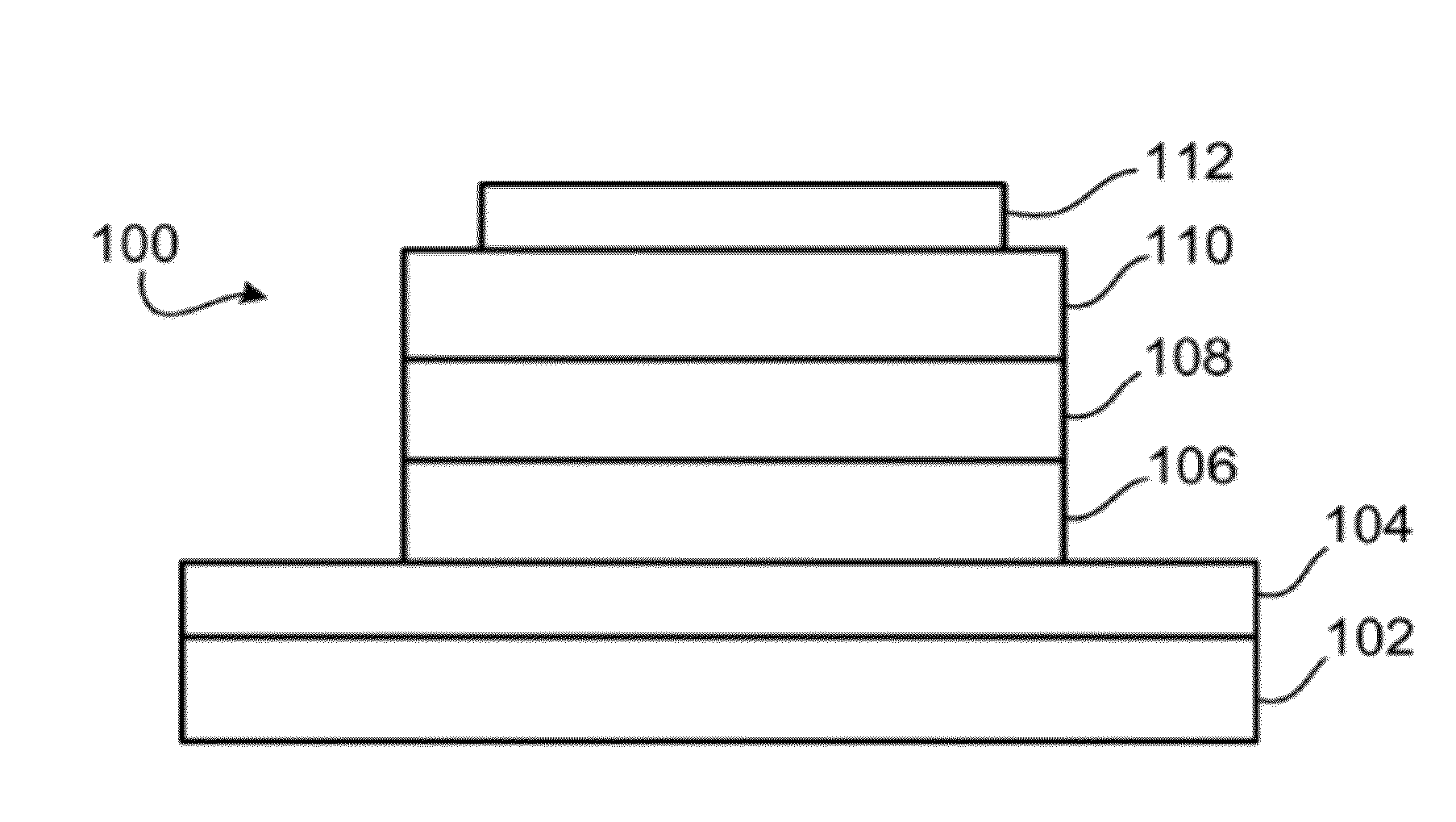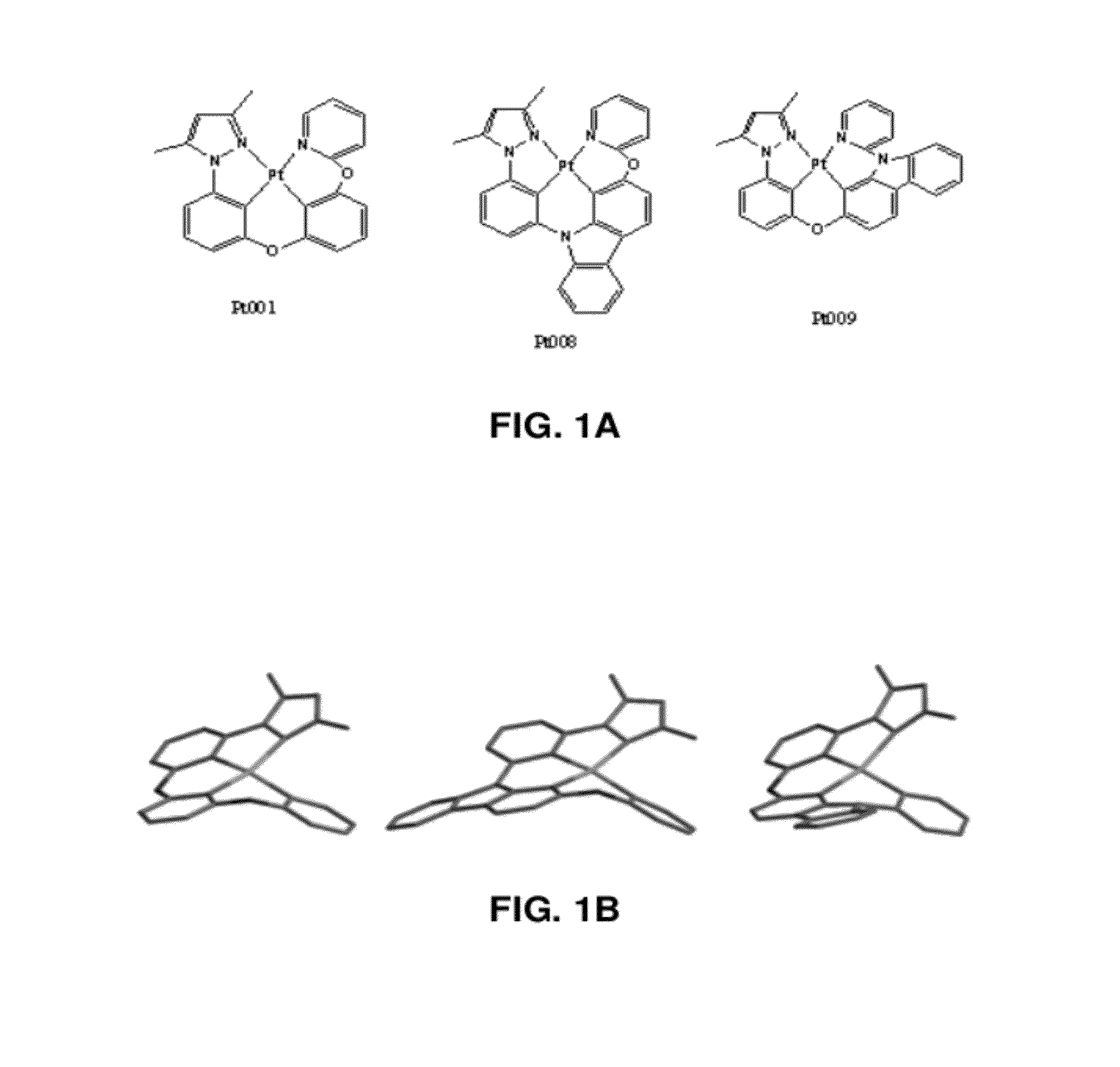Four coordinated platinum and palladium complexes with geometrically distorted charge transfer state and their applications in light emitting devices
a charge transfer state and charge transfer technology, applied in the field of platinum and/or palladium complexes, can solve the problems of poor processing ability, many materials currently used in optical and electro-optical devices, and many current devices containing organic or organometallic materials have yet to be optimized
- Summary
- Abstract
- Description
- Claims
- Application Information
AI Technical Summary
Benefits of technology
Problems solved by technology
Method used
Image
Examples
example 1
Pt-001
In a first example, a Pt-001 complex, as described herein, was synthesized. Initially, 3-(pyridine-2-yloxy)phenol was synthesized. Under a nitrogen atmosphere, a pressure vessel was charged with a magnetic stir bar, resorcinol (110 mmol), 2-bromopyridine (100 mmol), 1-methylimidazole (5 mmol), and potassium carbonate (200 mmol). Pyridine (80 mL) was added and bubbled with nitrogen for 20 minutes before copper(I) iodide (10 mmol) was added and bubbled 10 minutes further. The vessel was sealed and heated to 140° C. while stirring. After 2 days, the solution was allowed to cool. The solids were then filtered off and rinsed with a 50:50 mixture of toluene and methanol. The filtrate was reduced by rotary evaporation and 150 ml of water containing 10 mL glacial acetic acid was added and shaken vigorously. The water was decanted off and 50 mL of DCM was added, forming an off white precipitate which was collected by vacuum filtration and dried with ether, resulting in the pure product...
example 2
Pt-008
In a second example, a Pt-008 complex, as described herein, was synthesized according to the following scheme:
Initially, 2-tetrahydropyranyloxycarbazole was synthesized. To a solution of 2-hydrocarbanzole (2.7 g, 15 mmol) and PPTS (38 mg, 0.15 mmol) in DCM (150 mL) was added dropwise with 3,4-Dihydro-2H-pyran (1.4 mL, 15 mmol) in 10 minutes, and the mixture was stirred at 0° C. over night, which was monitored with TLC. The insoluble 2-hydrocarbanzole remained was then removed with filtration, and the solution was concentrated. The desired product was purified through an silica gel chromatography with hexane / ethyl acetate=10:1 as eluent. (0.7 g, white solid, 17% yield) 1H NMR (CDCl3): 1.58-1.77 (m, 3H), 1.88-1.93 (m, 2H), 1.99-2.10 (m, 1H), 3.60-3.67 (m, 1H), 3.90-4.03 (m, 1H), 5.49 (t, J=3.1 Hz, 1H), 6.95 (dd, J1=8.6 Hz, J2=2.1 Hz), 7.13 (d, J=2.4, 1H), 7.16-7.21 (m, 1H), 7.30-7.38 (m, 2H), 7.90-7.98 (m, 3H).
In another step, N-[3-(3,5-Dimethylpyrazolylphenyl)]-2-tetrahydropyra...
example 3
Pt-009
In a third example, a Pt-009 complex, as described herein, was synthesized according to the following scheme:
Initially, N-tetrahydropyranyl-2-tetrahydropyranyloxy-carbazole was synthesized. To a solution of 2-hydrocarbanzole (2.7 g, 15 mmol) and PPTS (38 mg, 0.15 mmol) in DCM (150 mL) was added dropwise with 3,4-Dihydro-2H-pyran (5 mL, 54 mmol) in 10 minutes, and the mixture was stirred at rt for 16 hours, which was monitored with TLC. The clear solution was concentrated. The desired product was purified through an silica gel chromatography with hexane / ethyl acetate=10:1 as eluent. (5.1 g, white solid, 96% yield).
In another step, N-tetrahydropyranyl-2-hydroxycarbazole was synthesized. To a 250 mL round flask was added with the solution of N-tetrahydropyranyl-2-tetrahydro-pyranyloxy-carbazole (1.77 g, 5.0 mmol) and PTSA (10 mg, 0.05 mmol) in ethyl acetate (100 mL), and the mixture was kept at rt over night. TLC showed that most of the disubstituted carbazole was transferred, an...
PUM
| Property | Measurement | Unit |
|---|---|---|
| temperature | aaaaa | aaaaa |
| mol % | aaaaa | aaaaa |
| mol % | aaaaa | aaaaa |
Abstract
Description
Claims
Application Information
 Login to View More
Login to View More - R&D
- Intellectual Property
- Life Sciences
- Materials
- Tech Scout
- Unparalleled Data Quality
- Higher Quality Content
- 60% Fewer Hallucinations
Browse by: Latest US Patents, China's latest patents, Technical Efficacy Thesaurus, Application Domain, Technology Topic, Popular Technical Reports.
© 2025 PatSnap. All rights reserved.Legal|Privacy policy|Modern Slavery Act Transparency Statement|Sitemap|About US| Contact US: help@patsnap.com



